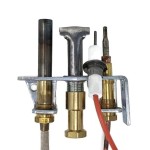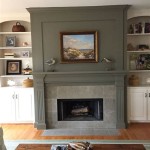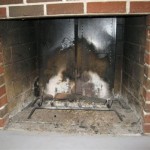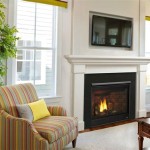How To Paint Brass Fireplace Doors
Brass fireplace doors, while aesthetically pleasing when new, can become tarnished, outdated, or simply clash with a new interior design scheme. Painting them offers a cost-effective way to refresh their appearance and integrate them seamlessly into a room's décor. This procedure, while seemingly simple, requires careful preparation and execution to ensure a durable and attractive finish. The success of the project depends significantly on proper surface preparation, the selection of appropriate paint, and the application technique.
Before embarking on the painting process, it's critical to understand the composition of the fireplace doors. While often referred to as "brass," many fireplace doors are actually brass-plated steel or other metals. This distinction influences the preparation methods and the types of primers and paints that will adhere most effectively. Identifying the underlying metal is essential for long-lasting results.
Proper ventilation is also a paramount safety consideration. Painting, especially with solvent-based products, can release harmful fumes. Working in a well-ventilated area or wearing a respirator is crucial to protect respiratory health. Additionally, protecting the surrounding surfaces with drop cloths or masking tape will prevent unwanted paint splatters.
Key Point 1: Preparing Brass Fireplace Doors for Painting
Surface preparation is arguably the most critical step in achieving a durable and professional-looking paint job on brass fireplace doors. A clean, smooth, and properly etched surface provides the key for paint adhesion. Neglecting this stage often results in chipping, peeling, and an overall unsatisfactory finish.
The first step involves removing the doors from the fireplace opening. This allows for easier access and prevents paint from inadvertently getting on the surrounding brick or stonework. Disconnecting any gas lines or electrical components should be done by a qualified professional prior to removing the doors if applicable. Safety is a leading concern during every step of the procedure.
Cleaning the doors is the next essential step. Use a degreasing detergent and warm water to remove any grease, soot, or grime. Abrasive cleaners should be avoided, as they may scratch the brass finish. A soft cloth or sponge is generally sufficient for this purpose. Rinse thoroughly with clean water and allow the doors to dry completely.
Once the doors are clean and dry, it's time to address any existing rust or corrosion. A wire brush or sandpaper can be used to remove loose rust. For more stubborn corrosion, a chemical rust remover may be necessary. Follow the manufacturer's instructions carefully when using these products. After removing the rust, clean the area again with a degreasing detergent and rinse thoroughly.
Sanding the brass surface is crucial for creating a textured surface that promotes paint adhesion. Use a fine-grit sandpaper (e.g., 220-grit) to lightly scuff the entire surface of the doors. The goal is not to remove the brass plating entirely (if applicable), but rather to create microscopic scratches that will allow the primer to grip the surface. After sanding, wipe the doors clean with a tack cloth to remove any sanding dust.
If the fireplace doors are indeed made of solid brass, consider using a metal etching primer after sanding. This type of primer contains chemicals that react with the brass, creating an even stronger bond between the metal and the paint. Etching primers are particularly effective on non-ferrous metals like brass, copper, and aluminum. Choose a primer specifically designed for metal and follow the manufacturer's instructions carefully.
Key Point 2: Selecting the Right Paint and Primer
The choice of paint and primer is paramount for achieving a durable and aesthetically pleasing finish on brass fireplace doors. Not all paints are created equal, and selecting the wrong type can lead to premature failure, such as chipping, peeling, or discoloration. Heat resistance is also a critical factor, given the proximity of the doors to the fireplace opening.
Primer serves as a crucial foundation for the paint, promoting adhesion and preventing corrosion. A high-quality metal primer is essential for brass fireplace doors, particularly if they are brass-plated steel. As mentioned before, an etching primer is beneficial for solid brass. Ensure the primer is compatible with the chosen topcoat paint.
For painting fireplace doors, heat-resistant paint is highly recommended, although not always strictly necessary if the doors are primarily decorative and not exposed to direct flames. High-temperature paints, often used for grills and automotive applications, can withstand temperatures up to 1200°F (649°C). These paints are typically available in spray cans and offer excellent durability and heat resistance.
If high-temperature paint is not required, a durable enamel paint may be suitable. Enamel paints provide a hard, glossy finish that is resistant to scratches and chipping. Both oil-based and water-based enamel paints are available, but oil-based enamel paints tend to be more durable and offer better adhesion on metal surfaces. Regardless of the choice, ensure the paint is explicitly designed for metal surfaces.
Consider the desired finish before selecting the paint. Flat, satin, semi-gloss, and gloss finishes are all available. Flat finishes are good at hiding imperfections, while gloss finishes are more reflective and easier to clean. Semi-gloss and satin finishes offer a balance between these two extremes. Consider the existing décor of the room when choosing a finish.
Spray paint is generally preferred for painting fireplace doors, as it provides a smooth, even finish without brush strokes. However, brush-on paints can also be used, especially for intricate designs or areas that are difficult to reach with a spray can. If using a brush, choose a high-quality brush designed for enamel paints to minimize brush strokes.
Key Point 3: Painting Technique and Application
Applying the paint correctly is crucial for achieving a professional-looking finish. Rushing the process or using improper techniques can result in runs, drips, uneven coverage, and other blemishes. Patience and attention to detail are key to success.
Before painting, it's essential to ensure that the primer is completely dry. Follow the manufacturer's recommended drying time, which is typically 24-48 hours. Sand the primed surface lightly with fine-grit sandpaper (e.g., 320-grit) to remove any imperfections and create a smooth base for the paint. Wipe the surface clean with a tack cloth before proceeding.
When using spray paint, hold the can approximately 10-12 inches away from the surface of the doors. Apply thin, even coats, overlapping each stroke slightly. Avoid spraying too much paint in one area, as this can lead to runs and drips. It's generally better to apply multiple thin coats rather than one thick coat.
If using a brush, apply the paint in smooth, even strokes, following the grain of the metal (if applicable). Avoid applying too much pressure, as this can cause brush strokes to be visible. Use a high-quality brush designed for enamel paints to minimize brush strokes. Work in a well-lit area to ensure adequate visibility.
Allow each coat of paint to dry completely before applying the next coat. Follow the manufacturer's recommended drying time, which is typically several hours. Sand lightly between coats with fine-grit sandpaper (e.g., 400-grit) to remove any imperfections and create a smooth surface. Wipe the surface clean with a tack cloth before applying the next coat.
Apply at least two coats of paint for optimal coverage and durability. More coats may be necessary for certain colors or finishes. Ensure that each coat is allowed to dry completely before handling the doors. Once the final coat of paint is dry, allow the doors to cure for several days before reinstalling them in the fireplace.
After the paint has fully cured, inspect the doors carefully for any imperfections. Touch up any blemishes with a small brush or spray can. Clean the doors with a mild detergent and water. Reinstall the doors in the fireplace, ensuring that all connections are secure. If any gas lines or electrical components were disconnected, have them reconnected by a qualified professional.
Maintaining the painted fireplace doors is crucial for preserving their appearance and prolonging their lifespan. Clean them regularly with a soft cloth and mild detergent. Avoid using abrasive cleaners or solvents, as they can damage the paint finish. Inspect the doors periodically for any signs of chipping or peeling and touch up any damaged areas promptly. With proper care and maintenance, painted brass fireplace doors can enhance the aesthetic appeal of a room for years.

Fireplace Door Update With Spray Paint Roots Wings Furniture Llc

Brass Painting S Instructions A Fireplace Black

Brass Fireplace Update East Coast Creative

How To Spray Paint A Brass Fireplace Insert Erfly House

Painted Fireplace Doors 6 Steps With S Instructables

How To Spray Paint A Brass Fireplace Bright Green Door

How To Update Brass Fireplace Surround Doors Krylon High Heat Spray Paint

How To Spray Paint A Brass Fireplace Insert Erfly House

Fireplace Door Update With Spray Paint Roots Wings Furniture Llc

Fireplace Brass Trim Can Be Painted To Get An Instant Living Room Makeover
Related Posts








